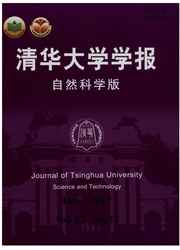

 中文摘要:
中文摘要:
Near-infrared( NIR) spectroscopy has been widely employed as a process analytical tool( PAT) in various fields; the most important reason for the use of this method is its ability to record spectra in real time to capture process properties. In quantitative online applications,the robustness of the established NIR model is often deteriorated by process condition variations,nonlinear of the properties or the high-dimensional of the NIR data set. To cope with such situation,a novel method based on principal component analysis( PCA) and artificial neural network( ANN) is proposed and a new sample-selection method is mentioned. The advantage of the presented approach is that it can select proper calibration samples and establish robust model effectively. The performance of the method was tested on a spectroscopic data set from a refinery process. Compared with traditional partial leastsquares( PLS),principal component regression( PCR) and several other modeling methods, the proposed approach was found to achieve good accuracy in the prediction of gasoline properties. An application of the proposed method is also reported.
 英文摘要:
英文摘要:
Near-infrared (NIR) spectroscopy has been widely employed as a process analytical tool (PAT) in various fields; the most important reason for the use of this method is its ability to record spectra in real time to capture process properties. In quantitative online applications, the robustness of the established NIR model is often deteriorated by process condition variations, nonlinear of the properties or the high-dimensional of the NIR data set. To cope with such situation, a novel method based on principal component analysis (PCA) and artificial neural network (ANN) is proposed and a new sample-selection method is mentioned. The advantage of the presented approach is that it can select proper calibration samples and establish robust model effectively. The performance of the method was tested on a spectroscopic data set from a refinery process. Compared with traditional partial leastsquares (PLS) , principal component regression (PCR) and several other modeling methods, the proposed approach was found to achieve good accuracy in the prediction of gasoline properties. An application of the proposed method is also reported.
 同期刊论文项目
同期刊论文项目
 同项目期刊论文
同项目期刊论文
 Fault Detection and Diagnosis for Non-Gaussian Processes with Periodic Disturbance Based on AMRA-ICA
Fault Detection and Diagnosis for Non-Gaussian Processes with Periodic Disturbance Based on AMRA-ICA Modeling and Optimization of a Steam System in a Chemical Plant Containing Multiple Direct Drive Ste
Modeling and Optimization of a Steam System in a Chemical Plant Containing Multiple Direct Drive Ste Online updating of NIR model and its industrial application via adaptive wavelength selection and lo
Online updating of NIR model and its industrial application via adaptive wavelength selection and lo High Dimension Feature Extraction based Visualized SOM Fault Diagnosis Method and Its Application in
High Dimension Feature Extraction based Visualized SOM Fault Diagnosis Method and Its Application in A New Sample Selection and Modeling Method Basedon Near-Infrared Spectroscopy and Its Industrial App
A New Sample Selection and Modeling Method Basedon Near-Infrared Spectroscopy and Its Industrial App Outlet TemperatureCorrelation and Prediction of Transfer Line Exchanger in an Industrial SteamEthyle
Outlet TemperatureCorrelation and Prediction of Transfer Line Exchanger in an Industrial SteamEthyle Synthesis and Optimization of the Utility Systemusing parameter adaptive differential evolution algo
Synthesis and Optimization of the Utility Systemusing parameter adaptive differential evolution algo A novel adaptive algorithm with near-infraredspectroscopy and its application in online gasoline ble
A novel adaptive algorithm with near-infraredspectroscopy and its application in online gasoline ble Tracking control of networked multi‐agent systems undernew characterizations of impulses and its app
Tracking control of networked multi‐agent systems undernew characterizations of impulses and its app An improved teaching-learning-based optimizationalgorithm for numerical and engineering optimization
An improved teaching-learning-based optimizationalgorithm for numerical and engineering optimization Optimization of p-xylene oxidation reaction processbased on self-adaptive multi-objective differenti
Optimization of p-xylene oxidation reaction processbased on self-adaptive multi-objective differenti Compartmentmodeling of coal gasification in an entrained flow gasifier: A study on theinfluence of o
Compartmentmodeling of coal gasification in an entrained flow gasifier: A study on theinfluence of o Onlineupdating of NIR model and its industrial application via adaptive wavelengthselection and loca
Onlineupdating of NIR model and its industrial application via adaptive wavelengthselection and loca Novel Control VectorParameterization Method with Differential Evolution Algorithm and itsApplication
Novel Control VectorParameterization Method with Differential Evolution Algorithm and itsApplication Multi-objective differential evolution withranking-based mutation operator and its application in ch
Multi-objective differential evolution withranking-based mutation operator and its application in ch An improved teaching-learning-based optimization algorithm for numerical and engineering optimizatio
An improved teaching-learning-based optimization algorithm for numerical and engineering optimizatio Compartment Modeling of Coal Gasification in an Entrained Flow Gasifier: A Study on the Influence of
Compartment Modeling of Coal Gasification in an Entrained Flow Gasifier: A Study on the Influence of Modelingand Optimization of a Steam System in a Chemical Plant Containing MultipleDirect Drive Steam
Modelingand Optimization of a Steam System in a Chemical Plant Containing MultipleDirect Drive Steam Dynamic Optimization of Chemical Processes UsingNonuniform Discretization Control Vector Parameteriz
Dynamic Optimization of Chemical Processes UsingNonuniform Discretization Control Vector Parameteriz 期刊信息
期刊信息
